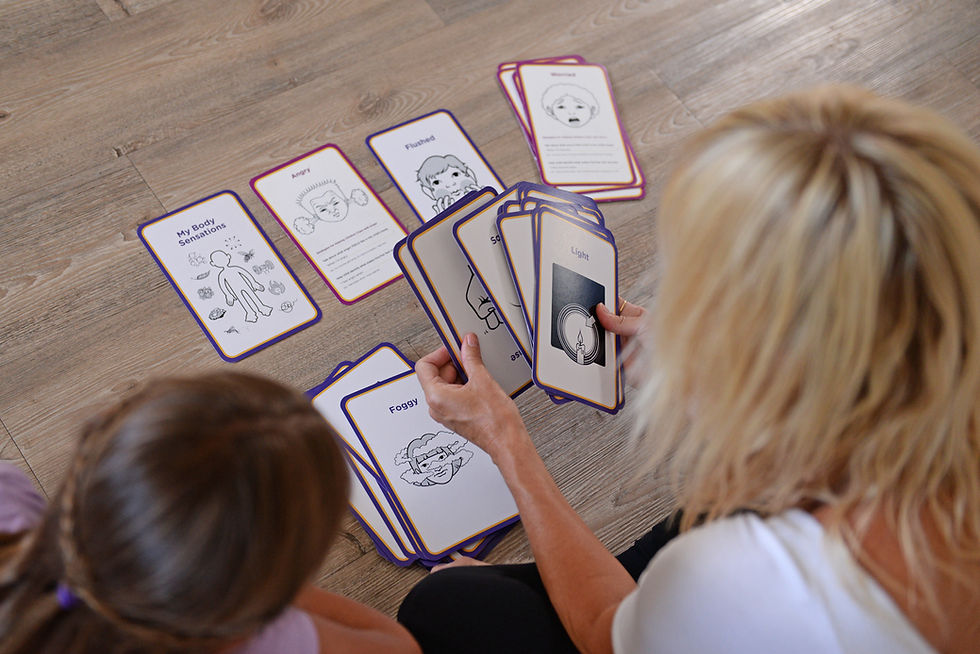Yoga Nidra Practice for Kids to Ease Bedtime Anxiety
- Shawnee Thornton Hardy

- Mar 20, 2020
- 3 min read
Updated: Mar 19, 2021
It's time for bed and your child is fidgety, anxious, worried and can't seem to wind down. Sound familiar?
"When our children struggle with bedtime and sleep, there's often a lot more going on beneath the surface."
They may have built up energy in the body that needs releasing and their nervous systems may be stuck in a hypervigilant state that makes it difficult for them to wind down. In order to actually get "rest" during sleep, we want our nervous systems to be in a parasympathetic state or the "rest and digest" state, rather than sympathetic (fight/flight). Many children who have active minds and/or a lot of internal energy can struggle with getting to sleep and sleeping through the night.
"Yoga Nidra is an ancient mind-body practice. The best way to describe it to children is that it is a deep rest practice that will help quiet the mind and calm the body."
Some of the benefits of this modified Yoga Nidra practice or Progressive Relaxation as referred to in the book (see details below) for kids, is that it supports more body awareness, interoceptive awareness (awareness of the internal senses), helps release built up tension or energy in the body, offers proprioceptive input for grounding and soothing the nervous system and can bring about a sense of calm and relaxation to support with better sleep.
Yoga Nidra (Progressive Relaxation) practice designed for children to do prior to bedtime.

Pre-pose preparation
Have the child watch the adult while seated. Describe what the words clench, tense, squeeze or tighten mean. Show the child how to clench, tense, squeeze or tighten the muscles in their body (e.g., adult squeezes fingers into a fist and says, "I squeeze my fingers"). Count to 5 as you squeeze your fists and then release your fingers and say "I relax my fingers". Repeat one or two more examples with different body parts for the child. Soothing music turned down low may be helpful in creating a calm and relaxing environment.
Note: the suggestion is to do this in bed prior to turning out light for sleep but this practice can be done on a mat, blanket on floor, couch or bed or seated in a chair.
Instructions for Child
Lie on back in bed
Feet wide apart.
Arms wide apart.
Close you eyes and squeeze them tight for "1, 2, 3, 4, 5".
Relax eyes.
Smile big with lips closed for "1, 2, 3, 4 ,5".
Relax lips.
Squeeze fingers tight into fist for "1, 2, 3, 4 ,5".
Relax fingers.
Squeeze elbows in tight to side body for "1, 2, 3, 4 ,5".
Relax arms.
Shrug shoulders up to ears and hold for "1, 2, 3, 4 ,5".
Relax shoulders.
Tighten belly muscles for "1, 2, 3, 4 ,5".
Relax belly muscles.
Squeeze butt muscles for "1, 2, 3, 4 ,5".
Relax butt muscles.
Squeeze legs together for "1, 2, 3, 4 ,5".
Relax legs.
Clench toes and hold "1, 2, 3, 4 ,5".
Relax toes.
Repeat from the toes up (number 21-1) to end with squeezing the eyes and squeezing out any last worried thoughts before going to sleep.
Option to just do number 1-21 without repeating backwards if the child does not have the attention span.
Guided imagery following Progressive Relaxation Practice
"Imagine lying on a towel at the beach. The warm sun is shining on your body. Your body is relaxed. Your towel is soft and cozy. Your body is relaxed. You hear the quiet sounds of the waves...shhhhh, shhhh, shhhh...your body is relaxed. You feel the warmth from the sun. Your body is relaxed. You see the colors of the blue waves. Your body is relaxed. The waves carry away any worries. Your body is relaxed. Your body feels heavy. Your body is relaxed."
Shawnee Thornton Hardy is a C-IAYT, Certified Yoga Therapist, M.Ed. Intermediate Somatic Experiencing Practitioner, the founder of Asanas for Autism and Special Needs and the Founder/Director of Yoga Therapy for Youth. She is the Author of Asanas for Autism and Special Needs - Yoga to Help children with Their Emotions, Self-Regulation and Body Awareness and the creator of the C.A.L.M.M Yoga Toolkit. She leads training throughout the US and internationally in Yoga for The Diverse Child, C.A.L.M.M Classroom (Yoga in Schools) and a 100-hour Yoga Therapy for Youth with Complex Needs training. Shawnee is in the process of writing another published book Yoga Therapy for Children and Teens with Complex Needs - Embodying a Whole Child Approach for Mental, Emotional and Physical Wellbeing.






Comments